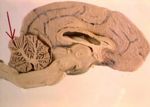Hindbrain - Anatomy & Physiology
Introduction
The hind brain is also called the rhombencephalon and is the brain stem that provides the connection between the spinal cord and the rest of the brain. The Reticular Formation is a diffuse interconnection of neurons running throughout the brain stem receiving both sensory and motor nerve tracts. This information is then passed on to higher centres in the brain such as the cerebrum. One inportant aspect of the resticular formation is that in order to transition from sleep to consciousness the reticular formation is required to activate the cerebral cortex. The hind brain contains many vital structures including the Medulla Oblongata, the Pons (the link between the cerebellum, forebrain and mid-brain) and the majority of the cranial nerves, III to XII. In general the brain stem governs essential functions that are carried out sub-consciously via reflexes.
As well as containing numerous cranial nerves, the hind brain also contains many 'Extra-pyramidal Pathways' which include the Reticular Formation, the Olivary Nucleus and the Pontine Nuclei. It also contains Cerebellar pathways and peduncles facilitating a connection from the brain stem to the cerebellum. There are also a number of 'Pyramidal Pathways' and afferent pathways including the Cuneate and Gracile pathways.
Nuclei within the hind brain are also responsible for the reflexive control of posture and eye movement.
Hind Brain Development
Hind Brain Structures & Functions
Medulla Oblongata
The Medulla Oblongata can be found within the Myelencephalon region of the hind-brain. Nuclei in the Medulla Oblongata control the level of heart activity including rate and contractility. The Medulla Oblongata also controls other related functions including blood pressure and distribution of blood to different organs. In conjunction with the nuclei found in the Pons, the Medulla Oblongata also exerts an influence on respiratory movements. The respiratory centre in the Medulla Oblongata is affected by various types of drugs including opiods such as Morphine. These types of drugs often suppress the activity of the neurones in the respiratory nuclei.
Pons
The Pons can be found in the Metencephalon region of the hind brain. As shown above, the Pons is able to exert some influence on respiratory movements and in some studies has also been shown to influence many digestive processes.
Cranial Nerves
Cerebellum
- The cerebellum:
- Inhibits upper motor neurons
- Co-ordinates movement
Species Differences
- The size of the brain differs between species, but otherwise the structure is quite constant.
Links
| This article is still under construction. |
